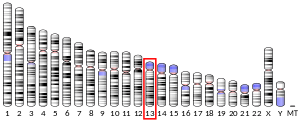SLITRK1
SLIT and NTRK-like protein 1 is a protein that in humans is encoded by the SLITRK1 gene.[5][6][7]
Members of the SLITRK family, such as SLITRK1, are integral membrane proteins with 2 N-terminal leucine-rich repeat (LRR) domains similar to those of SLIT proteins (see SLIT1; MIM 603742). Most SLITRKs, but not SLITRK1, also have C-terminal regions that share homology with neurotrophin receptors (see NTRK1; MIM 191315). SLITRKs are expressed predominantly in neural tissues and have neurite-modulating activity (Aruga et al., 2003).[supplied by OMIM][7]
References
- 1 2 3 GRCh38: Ensembl release 89: ENSG00000178235 - Ensembl, May 2017
- 1 2 3 GRCm38: Ensembl release 89: ENSMUSG00000075478 - Ensembl, May 2017
- ↑ "Human PubMed Reference:".
- ↑ "Mouse PubMed Reference:".
- ↑ Aruga J, Yokota N, Mikoshiba K (Oct 2003). "Human SLITRK family genes: genomic organization and expression profiling in normal brain and brain tumor tissue". Gene. 315: 87–94. doi:10.1016/S0378-1119(03)00715-7. PMID 14557068.
- ↑ Clark HF, Gurney AL, Abaya E, Baker K, Baldwin D, Brush J, Chen J, Chow B, Chui C, Crowley C, Currell B, Deuel B, Dowd P, Eaton D, Foster J, Grimaldi C, Gu Q, Hass PE, Heldens S, Huang A, Kim HS, Klimowski L, Jin Y, Johnson S, Lee J, Lewis L, Liao D, Mark M, Robbie E, Sanchez C, Schoenfeld J, Seshagiri S, Simmons L, Singh J, Smith V, Stinson J, Vagts A, Vandlen R, Watanabe C, Wieand D, Woods K, Xie MH, Yansura D, Yi S, Yu G, Yuan J, Zhang M, Zhang Z, Goddard A, Wood WI, Godowski P, Gray A (Oct 2003). "The secreted protein discovery initiative (SPDI), a large-scale effort to identify novel human secreted and transmembrane proteins: a bioinformatics assessment". Genome Res. 13 (10): 2265–70. doi:10.1101/gr.1293003. PMC 403697. PMID 12975309.
- 1 2 "Entrez Gene: SLITRK1 SLIT and NTRK-like family, member 1".
Further reading
- Nagase T, Kikuno R, Ohara O (2002). "Prediction of the coding sequences of unidentified human genes. XXI. The complete sequences of 60 new cDNA clones from brain which code for large proteins". DNA Res. 8 (4): 179–87. doi:10.1093/dnares/8.4.179. PMID 11572484.
- Strausberg RL, Feingold EA, Grouse LH, et al. (2003). "Generation and initial analysis of more than 15,000 full-length human and mouse cDNA sequences". Proc. Natl. Acad. Sci. U.S.A. 99 (26): 16899–903. doi:10.1073/pnas.242603899. PMC 139241. PMID 12477932.
- Aruga J, Mikoshiba K (2004). "Identification and characterization of Slitrk, a novel neuronal transmembrane protein family controlling neurite outgrowth". Mol. Cell. Neurosci. 24 (1): 117–29. doi:10.1016/S1044-7431(03)00129-5. PMID 14550773.
- Dunham A, Matthews LH, Burton J, et al. (2004). "The DNA sequence and analysis of human chromosome 13". Nature. 428 (6982): 522–8. doi:10.1038/nature02379. PMC 2665288. PMID 15057823.
- Gerhard DS, Wagner L, Feingold EA, et al. (2004). "The status, quality, and expansion of the NIH full-length cDNA project: the Mammalian Gene Collection (MGC)". Genome Res. 14 (10B): 2121–7. doi:10.1101/gr.2596504. PMC 528928. PMID 15489334.
- Abelson JF, Kwan KY, O'Roak BJ, et al. (2005). "Sequence variants in SLITRK1 are associated with Tourette's syndrome". Science. 310 (5746): 317–20. doi:10.1126/science.1116502. PMID 16224024.
- Burton A (2006). "SLITRK1 trouble in Tourette's syndrome". Lancet Neurology. 4 (12): 801. doi:10.1016/S1474-4422(05)70242-8. PMID 16323357.
- Wendland JR, Kruse MR, Murphy DL (2006). "Functional SLITRK1 var321, varCDfs and SLC6A4 G56A variants and susceptibility to obsessive-compulsive disorder". Mol. Psychiatry. 11 (9): 802–4. doi:10.1038/sj.mp.4001848. PMID 16936762.
- Zuchner S, Cuccaro ML, Tran-Viet KN, et al. (2006). "SLITRK1 mutations in trichotillomania". Mol. Psychiatry. 11 (10): 887–9. doi:10.1038/sj.mp.4001865. PMID 17003809.
This article is issued from
Wikipedia.
The text is licensed under Creative Commons - Attribution - Sharealike.
Additional terms may apply for the media files.



